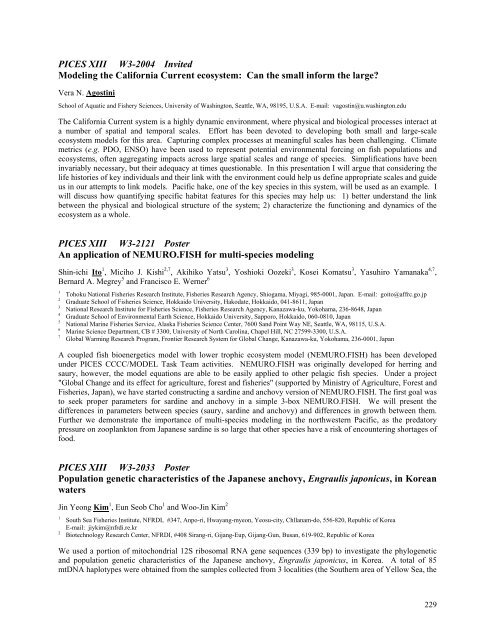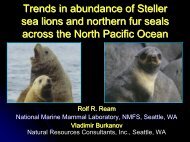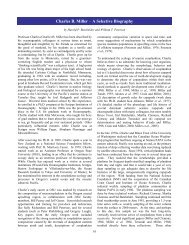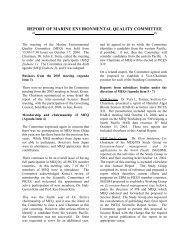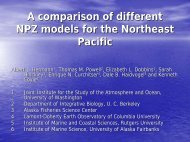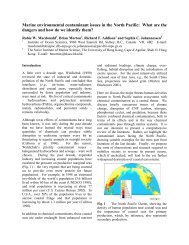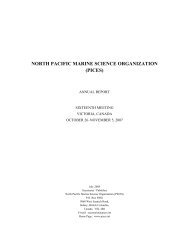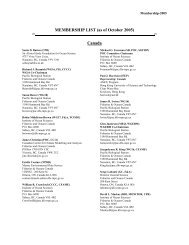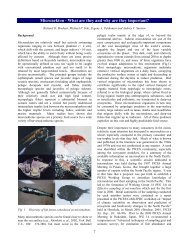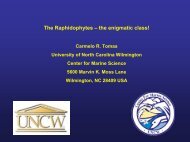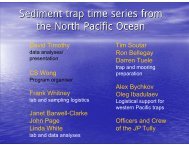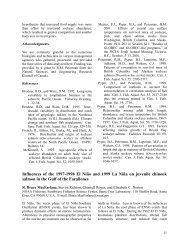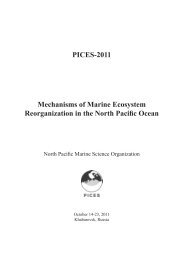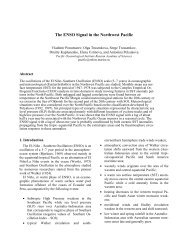13:30-14:10 Kosei Komatsu (Invited)Modeling of transportation of phyto- and zooplankton in the Kuroshio and Kuroshio Extension(W3-2012)14:10-14:50 Vera N. Agostini (Invited)Modeling the California Current ecosystem: Can the small inform the large? (W3-2004)15:10-15:50 Alec D. MacCall (Invited)Climate-driven fluctuations in fish stocks of the California Current (W3-2063)15:50-17:00 DiscussionIncorporation of spatial and/or seasonal variation into current CCCC-developed box models (NPZ,bioenergetics, or food web), or on specific places in current modeled regions (e.g. the subarcticNorth Pacific) where spatial variation and linkages will be critical to interpreting resultsDay 2 Saturday, October 16, 2004 9:00-17:00Section II (Co-Chairmen: Akihiko Yatsu and Gordon A. McFarlane)09:00-09:15 Introduction by Gordon A. McFarlane09:15-09:45 Jake SchweigertRecent distribution and ecology of sardines in the north-eastern Pacific Ocean (W3-2205)09:45-10:15 Akihiko Yatsu, Masayuki Noto, Minoru Ishida, Hiroshi Nishida and Maki SudaA review of the population dynamics of Japanese sardine in the Northwestern Pacific (W3-2182)10:15-10:35 Coffee break10:35-11:05 Motomitsu Takahashi, Hiroshi Nishida and Akihiko YatsuPreliminary study of growth of larval and early juvenile Japanese sardine in the Kuroshio-Oyashiotransition region (W3-2183)11:05-12:00 Discussion12:00-13:30 LunchSection III (Co-Chairmen: Kerim Aydin and Jin-Yeong Kim)13:30-17:00 DiscussionEach co-convener should present a short list from their Task Team or from the workshop on"possible future projects" hopefully arising out of the earlier portions of the workshop. Goal willbe to collect possibilities into a plan for future synthesis through new Task Team, CFAME(Climate Forcing and Marine Ecosystem Response). Section includes writing of workshoprecommendationsPostersShin-ichi Ito, Miciho J. Kishi, Akihiko Yatsu, Yoshioki Oozeki, Kosei Komatsu, Yasuhiro Yamanaka,Bernard A. Megrey and Francisco E. WernerAn application of NEMURO.FISH for multi-species modeling (W3-2121)Jin Yeong Kim, Eun Seob Cho and Woo-Jin KimPopulation genetic characteristics of the Japanese anchovy, Engraulis japonicus, in Korean waters (W3-2033)Yury I. Zuenko, Victoria V. Nadtochy and Marina S. SelinaNPZ monitoring in the coastal area of the Japan Sea (W3-1845)228
<strong>PICES</strong> XIII W3-2004 InvitedModeling the California Current ecosystem: Can the small inform the large?Vera N. AgostiniSchool of Aquatic and Fishery Sciences, University of Washington, Seattle, WA, 98195, U.S.A. E-mail: vagostin@u.washington.eduThe California Current system is a highly dynamic environment, where physical and biological processes interact ata number of spatial and temporal scales. Effort has been devoted to developing both small and large-scaleecosystem models for this area. Capturing complex processes at meaningful scales has been challenging. Climatemetrics (e.g. PDO, ENSO) have been used to represent potential environmental forcing on fish populations andecosystems, often aggregating impacts across large spatial scales and range of species. Simplifications have beeninvariably necessary, but their adequacy at times questionable. In this presentation I will argue that considering thelife histories of key individuals and their link with the environment could help us define appropriate scales and guideus in our attempts to link models. Pacific hake, one of the key species in this system, will be used as an example. Iwill discuss how quantifying specific habitat features for this species may help us: 1) better understand the linkbetween the physical and biological structure of the system; 2) characterize the functioning and dynamics of theecosystem as a whole.<strong>PICES</strong> XIII W3-2121 PosterAn application of NEMURO.FISH for multi-species modelingShin-ichi Ito 1 , Miciho J. Kishi 2,7 , Akihiko Yatsu 3 , Yoshioki Oozeki 3 , Kosei Komatsu 3 , Yasuhiro Yamanaka 4,7 ,Bernard A. Megrey 5 and Francisco E. Werner 61234567Tohoku National Fisheries Research Institute, Fisheries Research Agency, Shiogama, Miyagi, 985-0001, Japan. E-mail: goito@affrc.go.jpGraduate School of Fisheries Science, Hokkaido University, Hakodate, Hokkaido, 041-8611, JapanNational Research Institute for Fisheries Science, Fisheries Research Agency, Kanazawa-ku, Yokohama, 236-8648, JapanGraduate School of Environmental Earth Science, Hokkaido University, Sapporo, Hokkaido, 060-0810, JapanNational Marine Fisheries Service, Alaska Fisheries Science Center, 7600 Sand Point Way NE, Seattle, WA, 98115, U.S.A.Marine Science Department, CB # 3300, University of North Carolina, Chapel Hill, NC 27599-3300, U.S.A.Global Warming Research Program, Frontier Research System for Global Change, Kanazawa-ku, Yokohama, 236-0001, JapanA coupled fish bioenergetics model with lower trophic ecosystem model (NEMURO.FISH) has been developedunder <strong>PICES</strong> CCCC/MODEL Task Team activities. NEMURO.FISH was originally developed for herring andsaury, however, the model equations are able to be easily applied to other pelagic fish species. Under a project"Global Change and its effect for agriculture, forest and fisheries" (supported by Ministry of Agriculture, Forest andFisheries, Japan), we have started constructing a sardine and anchovy version of NEMURO.FISH. The first goal wasto seek proper parameters for sardine and anchovy in a simple 3-box NEMURO.FISH. We will present thedifferences in parameters between species (saury, sardine and anchovy) and differences in growth between them.Further we demonstrate the importance of multi-species modeling in the northwestern Pacific, as the predatorypressure on zooplankton from Japanese sardine is so large that other species have a risk of encountering shortages offood.<strong>PICES</strong> XIII W3-2033 PosterPopulation genetic characteristics of the Japanese anchovy, Engraulis japonicus, in KoreanwatersJin Yeong Kim 1 , Eun Seob Cho 1 and Woo-Jin Kim 212South Sea Fisheries Institute, NFRDI, #347, Anpo-ri, Hwayang-myeon, Yeosu-city, Chllanam-do, 556-820, Republic of KoreaE-mail: jiykim@nfrdi.re.krBiotechnology Research Center, NFRDI, #408 Sirang-ri, Gijang-Eup, Gijang-Gun, Busan, 619-902, Republic of KoreaWe used a portion of mitochondrial 12S ribosomal RNA gene sequences (339 bp) to investigate the phylogeneticand population genetic characteristics of the Japanese anchovy, Engraulis japonicus, in Korea. A total of 85mtDNA haplotypes were obtained from the samples collected from 3 localities (the Southern area of Yellow Sea, the229
- Page 3:
Keynote AddressPICES XIIISend out t
- Page 8 and 9:
14:50-15:10 Coffee break15:10-15:30
- Page 10 and 11:
PICES XIII S1-1827 PosterThe red fl
- Page 12 and 13:
PICES XIII S1-2018 InvitedRelation
- Page 14 and 15:
PICES XIII S1-2049 InvitedZooplankt
- Page 16 and 17:
forage base while physical gradient
- Page 19 and 20:
S2BIO Topic SessionMechanisms that
- Page 21:
09:20-09:40 Rubén Rodríguez-Sánc
- Page 24 and 25:
PICES XIII S2-1852 OralMechanisms o
- Page 26 and 27:
PICES XIII S2-2003 OralTop-down mod
- Page 28 and 29:
PICES XIII S2-2116 OralWhen, where
- Page 30 and 31:
espectively, several lines of evide
- Page 32 and 33:
PICES XIII S2-1939 InvitedWhy do om
- Page 34 and 35:
ased on optimal temperatures for la
- Page 37 and 38:
S3BIO Topic SessionRole of gelatino
- Page 39 and 40:
PICES XIII S3-1824 OralPredation on
- Page 41 and 42:
PICES XIII S3-1908 PosterSeasonal d
- Page 43 and 44:
stable-isotope ratios of carbon and
- Page 45 and 46:
PICES XIII S3-1930 OralA comparison
- Page 47 and 48:
S4FIS/BIO Topic SessionHot spots an
- Page 49:
17:00-17:20 Vincent F. Gallucci and
- Page 52 and 53:
PICES XIII S4-1983 OralExistence of
- Page 54 and 55:
the coast to 200 km offshore. More
- Page 56 and 57:
PICES XIII S4-1913 InvitedHow to di
- Page 58 and 59:
PICES XIII S4-2046 OralIdentifying
- Page 60 and 61:
PICES XIII S4-2097 InvitedAn oceano
- Page 62 and 63:
PICES XIII S4-1797 PosterZone of
- Page 65 and 66:
S5MEQ Topic SessionIntroductions of
- Page 67 and 68:
PICES XIII S5-1777 OralAnthropogeni
- Page 69 and 70:
PICES XIII S5-2178 OralThe Ballast
- Page 71 and 72:
Pseudo-nitzschia, causative organis
- Page 73:
PICES XIII S5-2139 OralIntroduced s
- Page 77 and 78:
PICES XIII S6-2203 OralMethods for
- Page 79 and 80:
PICES XIII S6-2104 PosterEcologic a
- Page 81 and 82:
S7POC/MONITOR Topic SessionApplicat
- Page 83:
PostersYury N. Volkov, Igor E. Koch
- Page 86 and 87:
PICES XIII S7-1801 OralEl Niño phe
- Page 88 and 89:
PICES XIII S7-2189 PosterMain effec
- Page 90 and 91:
PICES XIII S7-2090 PosterNorth Paci
- Page 92 and 93:
PICES XIII S7-1861 PosterSatellite
- Page 94 and 95:
almost constant over the whole year
- Page 96 and 97:
overestimation of chl-a in the Beri
- Page 98 and 99:
PICES XIII S7-2196 PosterInterannua
- Page 101 and 102:
S8POC Topic SessionThe impacts of c
- Page 103:
PostersAndrey G. Andreev and Viktor
- Page 106 and 107:
the Pacific Ocean. Analyses of the
- Page 108 and 109:
PICES XIII S8-1834 OralAttributing
- Page 110 and 111:
will report results of a workshop c
- Page 112 and 113:
PICES XIII S8-2047 InvitedMicrobial
- Page 114 and 115:
PICES XIII S8-2140 OralInterannual
- Page 116 and 117:
salinity showed similar distributio
- Page 119 and 120:
S9CCCC Topic SessionThe impacts of
- Page 121 and 122:
13:50-14:10 Randall M. Peterman, Br
- Page 123 and 124:
PICES XIII S9-1900 OralComparison o
- Page 125 and 126:
PICES XIII S9-1931 OralU.S. GLOBEC:
- Page 127 and 128:
PICES XIII S9-1807 OralDid regime s
- Page 129 and 130:
depth ranges are computed for summe
- Page 131 and 132:
PICES XIII S9-2131 OralA new intern
- Page 133 and 134:
PICES XIII S9-1894 OralThe latitudi
- Page 135 and 136:
Southern Oscillation Index) were of
- Page 137 and 138:
PICES XIII S9-1789 OralPopulation d
- Page 139 and 140:
PICES XIII S9-2076 OralProgresses a
- Page 141 and 142:
PICES XIII S9-2108 OralThe importan
- Page 143 and 144:
PICES XIII S9-1968 OralInterannual
- Page 145:
PICES XIII S9-1871 OralChanging oce
- Page 148 and 149:
PostersIrina V. IshmukovaAssessing
- Page 150 and 151:
PICES XIII S10-2041 OralQuantifying
- Page 152 and 153:
PICES XIII S10-2083 PosterModeling
- Page 154 and 155:
phytoplankton growth throughout the
- Page 157 and 158:
PICES XIII S11-1806 E-posterResearc
- Page 159 and 160:
PICES XIII S11-1975 E-posterDevelop
- Page 161:
cyclonic eddy field and then moved
- Page 164 and 165:
Eun Seob ChoPCR-based assays for de
- Page 166 and 167:
PICES XIII BIO_P-1980 PosterPCR-bas
- Page 168 and 169:
marine organisms. Acoustic methods
- Page 170 and 171:
the total copepod biomass through t
- Page 172 and 173:
PICES XIII BIO_P-1770 PosterCommuni
- Page 174 and 175:
16:05-16:20 Andre Buchheister and M
- Page 177 and 178:
PICES XIII FIS_P-1814 PosterModelin
- Page 179 and 180:
around the islands. In 1993, there
- Page 181 and 182:
coefficient. The model comparison u
- Page 183 and 184: central region of the Bungo Channel
- Page 185 and 186: PICES XIII FIS_P-1950 PosterDensity
- Page 187 and 188: PICES XIII FIS_P-1995 OralInterannu
- Page 189 and 190: variability in age class structure
- Page 191 and 192: PICES XIII FIS_P-1957 OralGeographi
- Page 193 and 194: PICES XIII FIS_P-1831 PosterGrowth
- Page 195 and 196: General Poster SessionWednesday, Oc
- Page 197: Nina I. Savelieva, Vladimir I. Pono
- Page 200 and 201: PICES XIII GP-1962 PosterNew compre
- Page 202 and 203: PICES XIII GP-2019 PosterMultiyear
- Page 204 and 205: PICES XIII GP-1839 PosterDeath of t
- Page 206 and 207: PICES XIII GP-1799 PosterStock enha
- Page 208 and 209: PICES XIII GP-1891 PosterSeamounts
- Page 210 and 211: PICES XIII GP-1905 PosterBiomarkers
- Page 212 and 213: etween 170˚E and 166˚W. In most c
- Page 214 and 215: ottom layers because of denitrifica
- Page 216 and 217: has increased. But in the Norwegian
- Page 218 and 219: PICES XIII GP-1841 PosterHorizontal
- Page 221: W1MIE-AP Workshop and Advisory Pane
- Page 224 and 225: 11:45-12:10 Hyun-Cheol Kim, Sinjae
- Page 226 and 227: PICES XIII W2-1932 PosterGrowth rat
- Page 228 and 229: Copepods were abundant in April and
- Page 230 and 231: PICES XIII W2-2082 OralSeasonal cyc
- Page 233: W3CCCC WorkshopLinking open ocean a
- Page 237 and 238: characteristic cyclic relationship.
- Page 239 and 240: W4PICES/CLIVAR WorkshopScale intera
- Page 241: 13:30-14:15 Richard A. Feely, C. L.
- Page 244 and 245: PICES XIII W4-1984 InvitedCLIVAR/CO
- Page 246 and 247: PICES XIII W4-1992 InvitedThe impac
- Page 248 and 249: PICES XIII W4-2155 InvitedGlobal li
- Page 250 and 251: the subtropic Northwest Pacific and
- Page 252 and 253: Environmental changes at inter-annu
- Page 254 and 255: 14:30-15:00 Discussion of usefulnes
- Page 257 and 258: W5 Workshop AbstractsPICES XIII W5-
- Page 259 and 260: PICES XIII W5-2193 OralUse of Korea
- Page 261 and 262: HAB Meeting AbstractsPICES XIII HAB
- Page 263 and 264: PICES XIII HAB-2039 OralThe use of
- Page 265: W6MBM-AP WorkshopCombining data set
- Page 268 and 269: PICES XIII W6-1973 OralDistribution
- Page 271 and 272: Index of AuthorsPresenter Name: Pap
- Page 273 and 274: DDagg, Michael S3-1979 p.33Daly, El
- Page 275 and 276: IIanson, Debby S8-2147 p.104Ichihar
- Page 277 and 278: Kruse, Gordon H. FIS_P-1873 p.182S2
- Page 279 and 280: Nagasawa, Toru FIS_P-1922 p.175Naka
- Page 281 and 282: Samko, Eugene V. S4-1815 p.53Samuel
- Page 283 and 284: Vinnikov, Andrey V. FIS_P-2088 p.18
- Page 285:
PICES AcronymsAP Advisory PanelAPN


